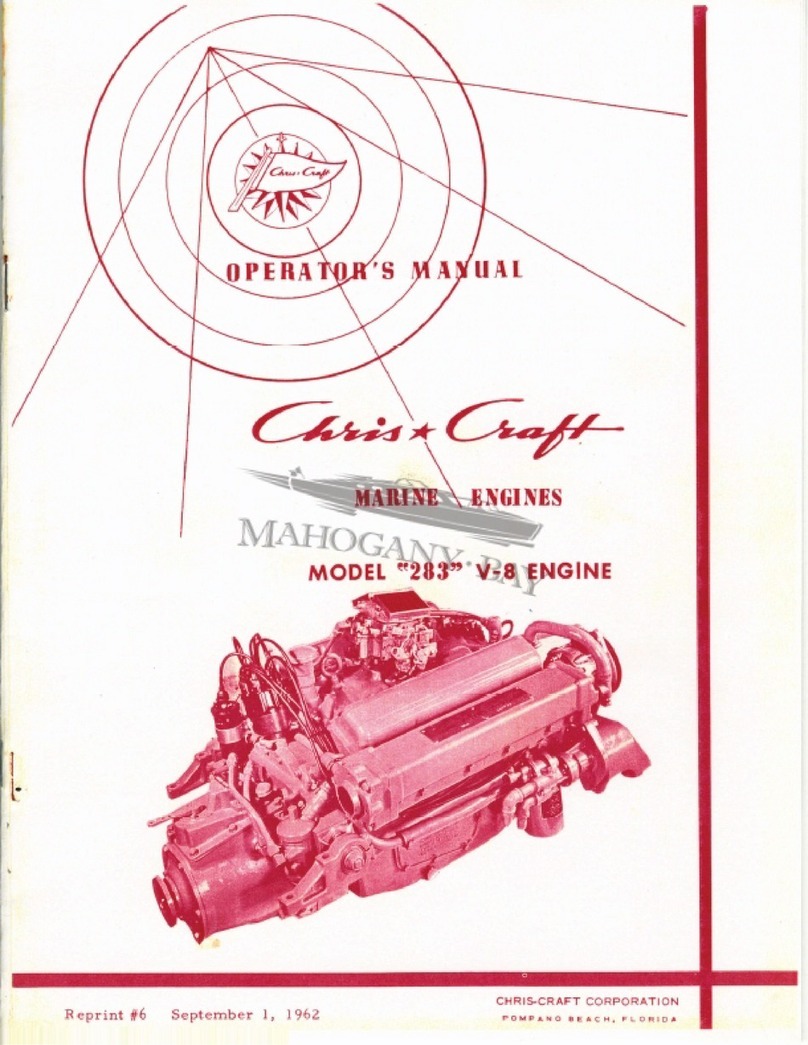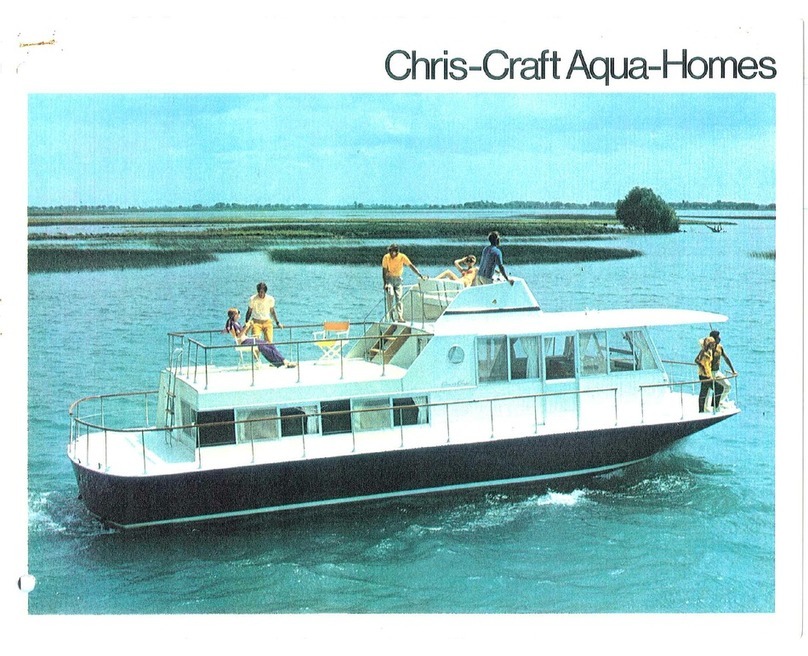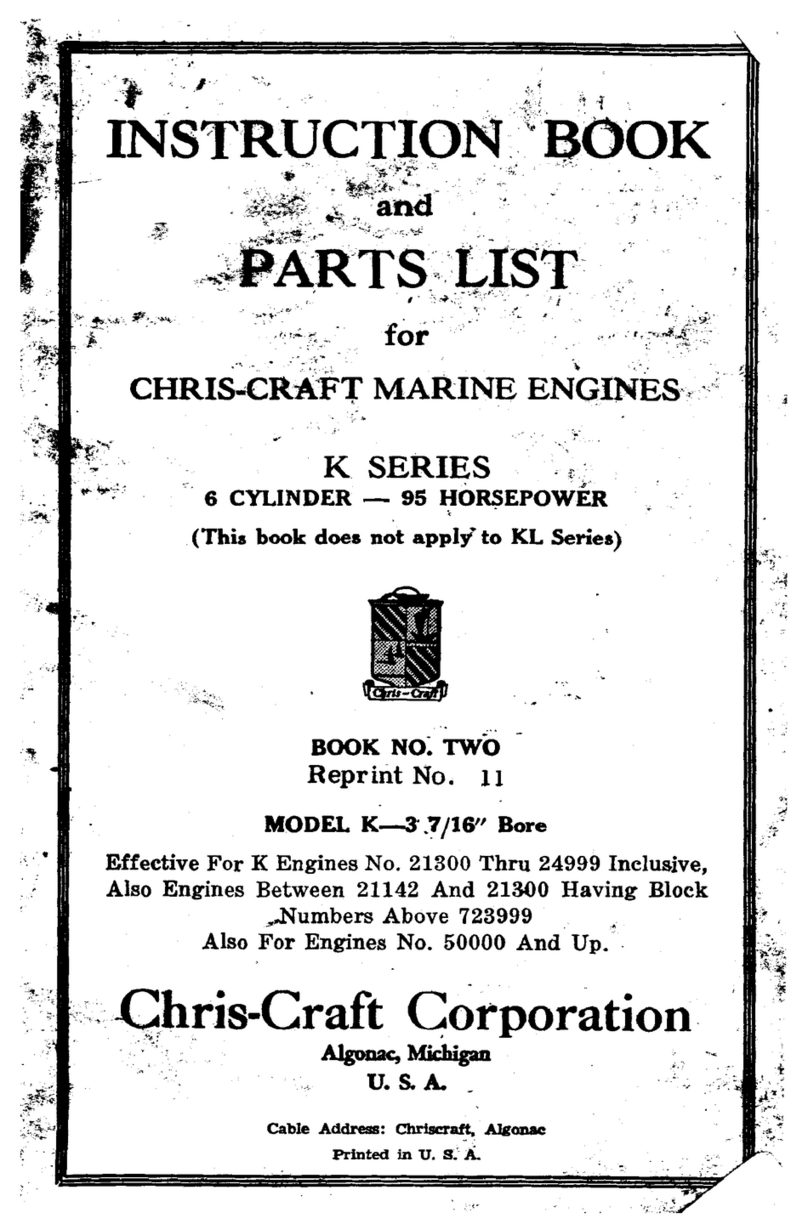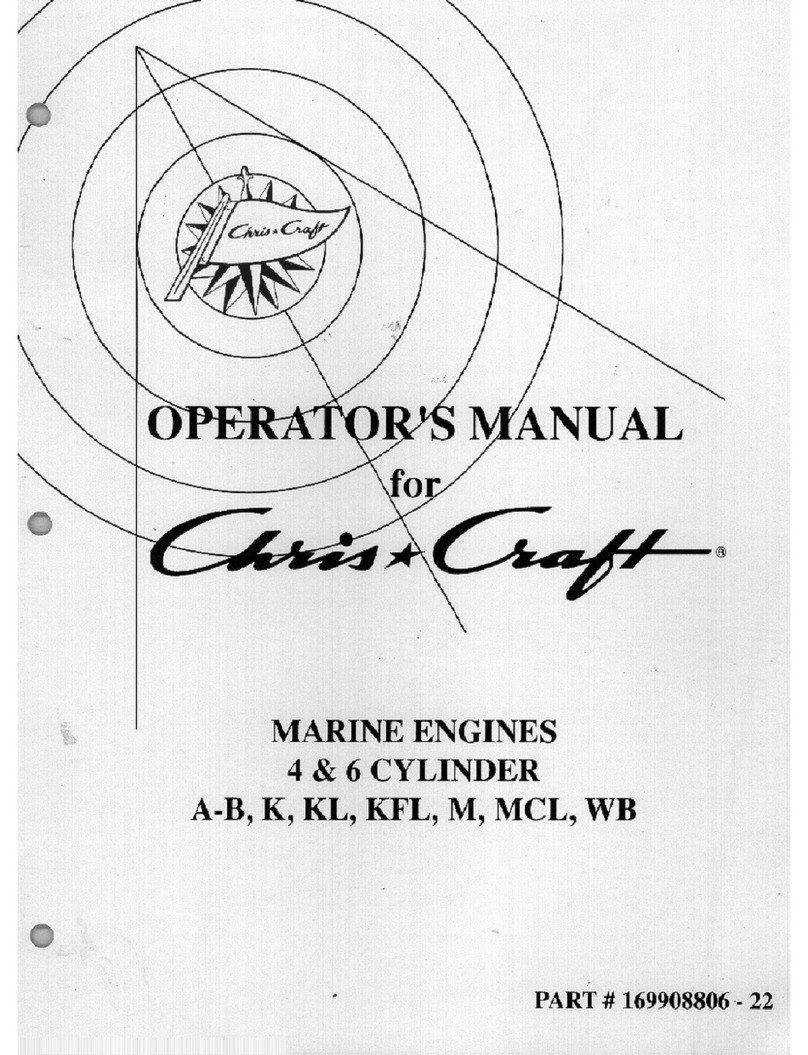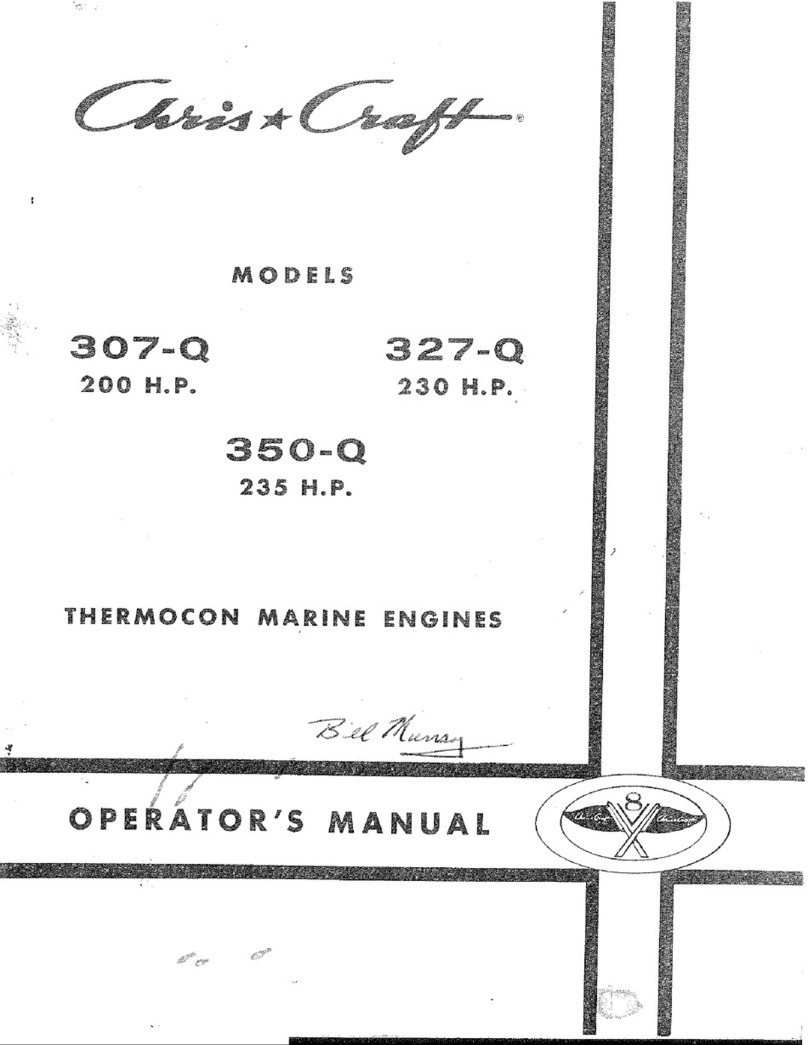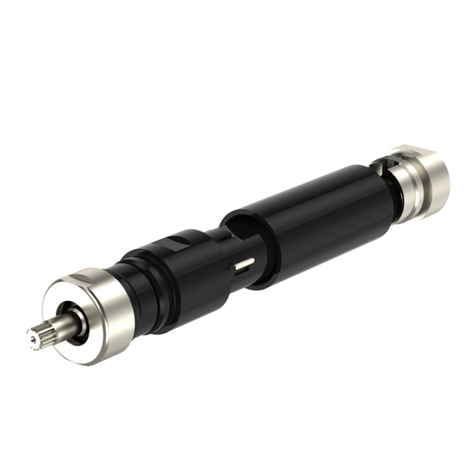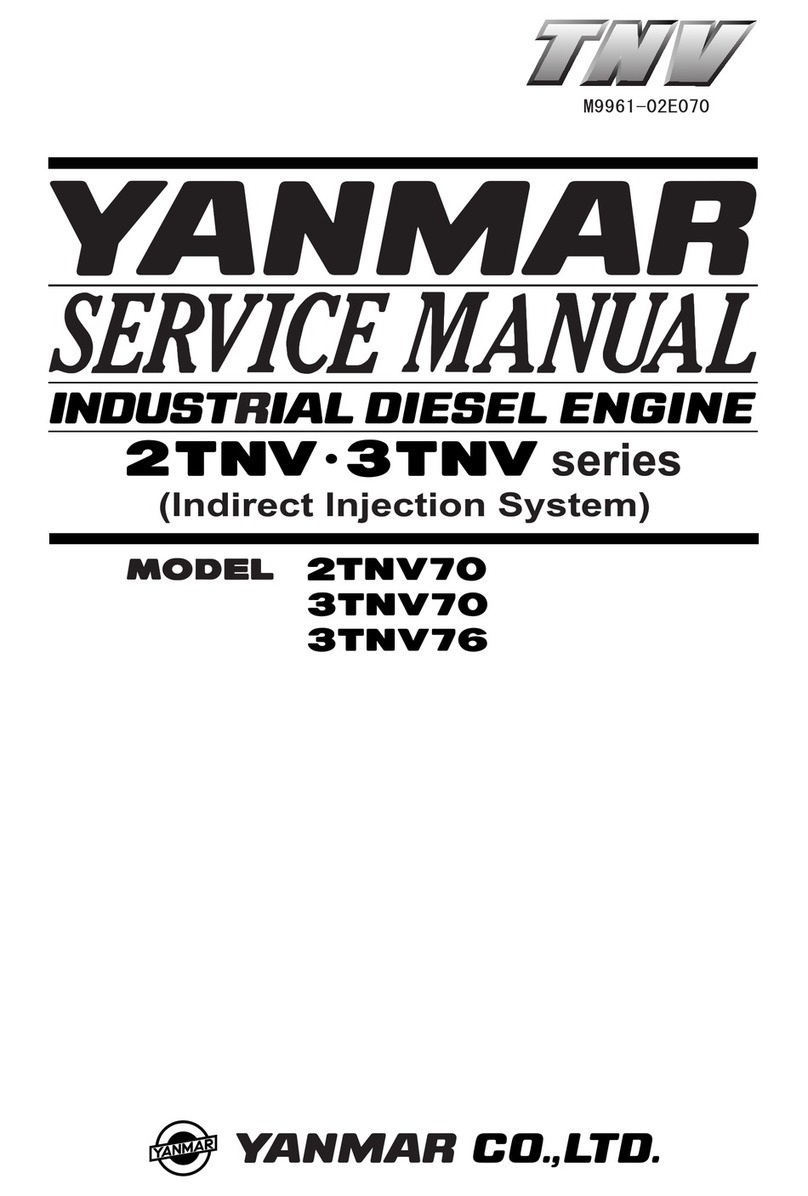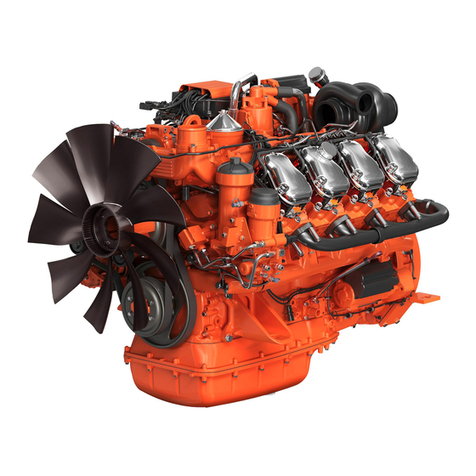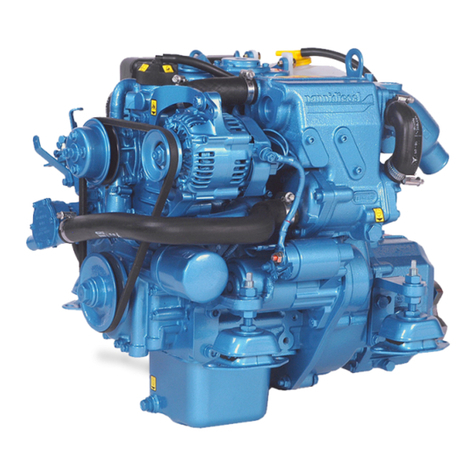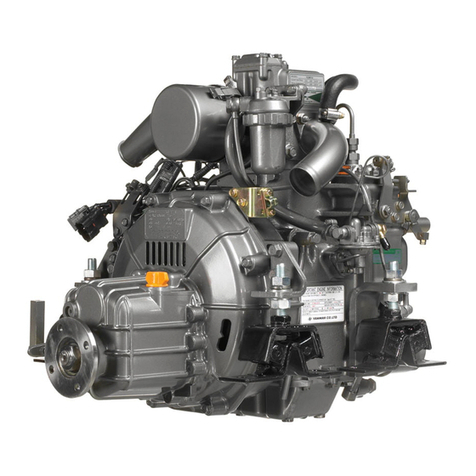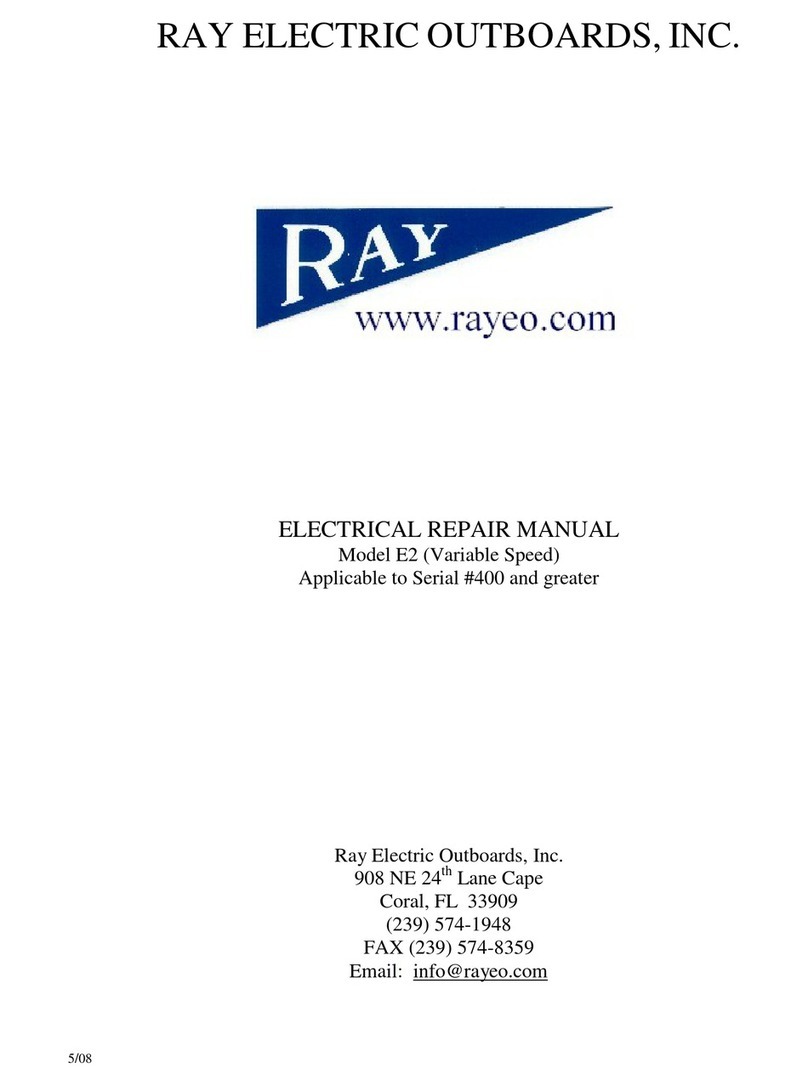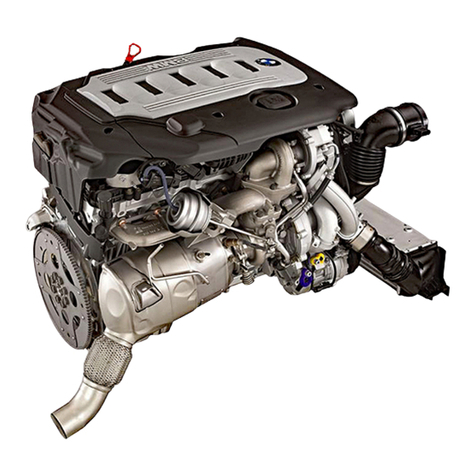Chris-Craft 283 V-8 User manual

0
P
E
ADD
S
0
AN
UAL
MODEL
2
t
V
ENGINE
CHRIS
CRAFT
CORPORATION

TO
ORDER
PARTS
ENGINE
MODEL
and
ENGINE
SERIAL
NUMBER
must
be
furnished when
replacement
parts
are
required
The
model
designation
T
and
serial
number
will
be
found
stamped
into
a
plate
fastened
on
top
of
the
exhaust manifold
ILLUSTRATION
OF
ENGINE
PLATE
M
ZQ
G3
a
C
t
Ep
G
B
CA
C
WHEN
ORDERING
PARTS
FIRING
ORDER
USE
ONLY
HIGH
GRADE
SPECIFY MODEL
AND
MODEL
HEAVY
DUTY
MARINE
ENGINE
NUMBER
ENGINE
OIL
SAE
30
CHRIS
CRAFT
CORPORATION
POMPANO
BEACH
FLORIDA
USA
Order
parts
from
your
nearest
Chris
Craft
dealer
or
direct
from
Chris
Craft
Cor
poration
Service
Parts
Department
Algonac
Michigan
being
sure
to
furnish
num
bers
mentioned
above
For
the
best
performance
from
your
engine
INSIST
ON
GENUINE
CHRIS
CRAFT
PARTS
CHRIS
CRAFT
C
O
R P
O
R
A
T
I
O
N
Pompano
Beach
Florida
USA

WARRANTY
Chris
Craft
boats
and
Chris
Craft
parts
manufactured
by
company
are
warranted
to
be free
from
defects
in
material
or
workmanship
under
normal
use
and
service
and the
com
pany
will
replace
or
repair
any
part
thereof
which
shall
dis
close
defects
within
SIX
MONTHS
after
date
of
delivery
of
such
boat
or
part
to
the
original
purchaser
and
which
exam
ination
by
Company
shall
determine
to
be
defective
providing
that
Dealer
shall
make
claim
thereon
and
return
said
part
or
parts
to
Company
transportation
prepaid
within
30
days
after
defect
is
discovered
The
Company
does
not
authorize
Dealer
to
assume
for
Company
any
liability
in
connection
with
this
warranty
Paints
varnisbes
and
chromium
plate
finishes
are
believed
by
the
Company
to
be
the
best
obtainable
bowever
cannot
be
guaranteed
because
of
the
varying
effects
which
different
climates
and
use
conditions
have
on
the
same
This
Warranty
shall
not
apply
to
any
Chris
Craft
boat
or
part
manufactured
by
Company
which
shall
have
been
al
tered
or
repaired
outside
of
the
factories
of
Company
This
Warranty
will
not
apply
to
any
engines
engine
ac
cessories
or
trade
accessories
not
of
Company
s
manufacture
which
Company
may
use
as
these
are
generally
warranted
by
their
respective
manufacturers
This
Warranty
does
not
cover
race
boats
or
racing
en
gines
Catalogue
speeds
are
estimated
or
are
attained
over
a
certified
course
at
Algonac
Michigan
under
favorable
con
ditions
and
are
not
guaranteed
Chris
Craft
Corp

TABLE
OF
CONTENTS
YOUR
NLW
CHRIS
CRAFT
MARINE
ENGINE
Identification
Use
Genuine
Factory
Replacement
Parts
B
r
eak
In
To
Start
Engine
LUBRICATION
SYSTEM
Oil Pressure
Oil
Recommendation
To
Change
Engine
Oil
ELECTRICAL
SYSTEM
Ignition
Timing
Ignition
Circuit
Battery
Generator
Voltage
Regulator
Starting
Motor
FUEL
SYSTEM
Fuel
Recommendation
Carburetor
Fuel
Pump
COOLING
SYSTEM
Water
Temperature
Water
Pump
VALVES
VALVE
TAPPETS
REVERSE
GEAR
Paragon
Manual
Paragon
Hydraulic
Chris
O
Matic
ANNUAL
LAY
UP
ANNUAL
FITTING
OUT
MAINTENANCE
SCHEDULE
ENGINE
INSTALLATION
RECOMMENDATIONS
Mounting
Alignment
Exhaust
Recommended
Exhaust
Size
Engine
Control
Instruments
INFORMATION
AVAILABLE
R
OTAT10N
DIAGRAM
MAJOR
PARTS
OF
CHRIS
CRAFT
V
8
ENGINE
DIAGRAM
WIRING
DIAGRAM
6
7
8
8
12
3
13
i4
16
16
17
18

Page
3
YOUR
NEW
CHRIS
CRAFT
MARINE
ENGINE
Your
Chris
Craft
Marine
Engine
has
been
delivered
to
you
only
after
a
great
deal
of
skillful
engineering
careful
manufacture
and
exhaustive
testing
Chris
Craft
s
years
of
practical
experience
in
the
marine
field
are
packed
into
every
engine
leaving
our
plant
With
reasonable
care
during
operation
and
a
minimum
amount
of
maintenance
this
engine
will
deliver
a
maximum
amount
of
dependable
economical
performance
and
long
life
IDENTIFICATION
On
every
engine
there
is
a
plate
on
top
of
the
manifold
giving
the
model
and
serial
num
ber
This
information
is
important
and
should
be
included
in
all
parts
orders
and
cor
respondence
relating
to the
engine
A
typical
name
plate
is
shown
on
the
inside
front
cover
USE
GENUINE
FACTORY
REPLACEMENT
PARTS
All
Chris
Craft
Marine
Engines
have
special
parts
designed
to
give
the
best
perfor
mance
under
conditions
found
only
in
marine
use
To
insure
long
life
and
dependable
performance
we
strongly
recommend
that
only
factory
replacement
parts
be
used
These
may
be
obtained
from
your
nearby
Chris
Craft
Dealer
or
directly
from
thefac
tory
Internal
engine
parts
of other
manufacture
are
plainly
marked
in
the
parts
lists
and
these
parts
may
be
obtained
from
the
manufacturer
and
his
distributors
BREAK
IN
It
is
very
important
that the
engine
be
broken
in
properly
All
moving
parts
in
the
en
gine
are
new
and
have
only
been
run
for
a
few
hours
while
the
engine
had
its
final
test
Engines
must
be
run
carefully
in
the
beginning
until
all
parts
are
worn
in
and
the
en
gine
becomes
limber
Only
then
will
it
be
safe
to
run
the
engine
fast for
sustained
per
iods
of
time
Running
new
engines
or
engines
after
a
major
overhaul
at
excessively
low
RPM
for
long
periods
should
be
avoided
because
it
will
tend
to
prolong
the
break
in
period
and
delay
proper
seating
of
piston
rings
During
the
first
ten
hours
operation
do
not
exceed
2500
RPM
During
the
second
ten
hours
operation
do
not
exceed
3200
RPM
We
do
not
recommend
turning
this
engine
in
excess
of
3600
RPM
Use
in
excess
of
4000
RPM
voids
factory
warranty
To
tell
how
the
break
in
of
the
engine
is
progressing
let
the
engine
run
at
approxi
mately
1000
RPM
turn
off
the
ignition
key
and
note
how
quickly
the
engine
comes
to
a
stop
The
new
engine
will
stop
at
once
but
as
the
break
in
process
progresses
andthe
engine
becomes
more
limber
it
does
not
stop
as
suddenly
Aii
abnormal
rise
in
engine
temperature
will
indicate
that
the
engine
is
being
run
a
little
too
fast
During
the
entire
life
of
the
engine
always
run
the
engine
at
medium
speeds
to allow
the
oil
to
warm
up
before
running
at
sustained
high
speeds
When
coming
to
the
dock
after
a
run
always
allow
the
engine
to
run
at
moderate
speed
for three to
five
minutes
before
turning
off
the
ignition
This
can
be
done
by
slowing
down
several
hundred
yards
before
you
get
to
the
dock
and
coming
in
slow
or
letting
the
engine
idle
after
you
have
come
into
the
dock
This
is
to
allow
the
valves
to
cool
down
while
the
water
is
stillcir
culating
in
the
engine
This
will
help
prevent
warped
valves

Page
4
TO
START
ENGINE
Before
starting
the
new
engine
check
the
oil level
in
the
crankcase
check
fuel in
tank
and
ventilate
engine
compartment
thoroughly
Shift
the
reverse
gear
to
neutral
posi
tion
Open
the
throttle
slightly
approximately
18
open
Turn
switch
on
operating
fuel
pump
until
fuel
lines fuel
filter
and
carburetor
are
full
Then
depress
starter
button
or
turn
key
all
the
way
to
the
right
to
engage
the
starter
Do
not
engage
the
starter
for
prolonged
periods
If
the
engine
does
not
start
immediately
investigate
the
cause
of
trouble
As
soonas
the
engine
starts release
the
starter
Check
to
make
sure
that oil
pressure
is
present
and
that
cooling
water
is
circulating
This
engine
is
equipped
with
an
automatic
choke
If
the
engine
does
not
start
due
to
flooding
the
throttle
should
be
opened
fully
which
will
reduce
the
choking
action
The
starter
should
be
engaged
with
throttle
opened
fully
As
soon
as
engine
starts
close
the
throttle
When
taking
the
boat
out
always
run
the
engine
at
moderate
speed
until
the
oil
warms
up
When
returning
always
allow
the
engine
to
run
slowly
for
several
minutes
before
shutting
it
off
This
will
greatly
extend
the
life
of
the
valves
To
accomplish
this
many
owners
plan
to
idle
their
engines
for
the
last
several
hundred
yards
travelled
Before
engaging
or
disengaging
the
reverse
gear
it
is
advisable
to
slow
the
engine
down
to
1000
RPM
or
less
Shifting
at
higher
RPM
will
shorten
the
life
of
the
reverse
gear
and
may
cause
damage
LUBRICATION
SYSTEM
OIL
PRESSURE
Form
the
habit
of
watching
the
oil
pressure
gauge
Advance
notice
of
serious trouble
is
nearly
always
indicated
by
the
oil
gauge
Oil
pressure
should
be
approximately
18
lbs
at
idle
speed
and
35
to
45
lbs
at
maxi
mum
speed
with
the
engine
hot
ENGINE
OIL
RECOMMENDATION
Chris
Craft
Marine
Engines
should
be
serviced
with oil of
good
character
and
quality
to
insure
smooth
operation
freedom
from
trouble
and
best
engine
performance
obtain
able
A
Marine
engine
works
at
maximum
capacity
90
of
the
time
while
an
automo
bile
engine
rarely
works
at
its
maximum
even
1015
percent
of
the
time
Therefore
the
requirements
for
a
good
lubricating
oil
are
far
greater
in
a
marine
engine
We
recommend
the
use
of
S
A E
430
lubricating
oil
containing
detergents
and
addi
tives
conforming
to API
designation
MS
or
DG
U
S
Military
Spec
MIL
L
2104
A
or
supplement
1
or
I
C
E
I
designation
A
or
B
It
is not
recommended
that
different
brands
of oil
be
mixed
Always
replenish
with
the
same
make
and
type
of
oil that is in
the
crankcase
Ifit
is
necessary
to
change
the
make
of
oil
always
drain
the
crankcase
as
completely
as
possible
before
refilling
TO
CHANGE
ENGINE
OIL
The
new
engine
when
shipped
is
filled
with
S
A E
10
break
in
oil
After
ten
to
fif
teen
hours
running
this
oil
should
be
replaced
with
S
A
E
30
motor
oil
Thereafter
the
oil
should
be
changed
every
fifty
to
one
hundred
hours
depending
upon
the
type
of

Page
5
service
to
whichthe
engine
is
subjected
An
engine
that
is
used
for
short
runs
needs
an
oil
change
more
often
than
an
engine
which
is
run
longer
periods
of
time
as
long
runs
permit
the
oil
to
attain
proper
operating
temperature
at
which
there
is
less
possibility
of
contamination
and
the
oil
will
remain
clean
longer
To
remove
the old
oil from
the
crankcase
the
best
method
is
to pump
the
oil
out
with
a
suction
pump
The
suction
tube
maybe
inserted
into
the
oil
test
rod
opening
or
through
the
14
plugged
hoe
on
the
side
of
the
oil
pan
next
to
the
test
rod
hole
The
oil
may
be
pumped
out
of
the
reverse
gear
except
Paragon
Hydraulic
gears
by
removing
the
reverse
gear
top
cover
and
pumping
the
oil
out
of
this
unit
On
engines
withreduction
gears
there
will
remain
from
1
to
112
quarts
in
that
unit
which
cannot
be
removed
Most
marine
service
stations
are
equipped
with
special
pumps
for this
purpose
A
suitable
hand
pump
may
be
purchased
from
the
Chris
Craft
Service
Parts
Department
at
Algonac
Michigan
Direct
drive
Model
283
engines
hold
approximately
7
quarts
of oil
but
this
amount
will
vary
depending
upon
the
installation
angle
Engines
equipped
with
reduction
gears
will
hold
an
additional
1
to
1
1
2
quarts
of
oil
ELECTRICAL
SYSTEM
The
electrical
equipment
on
the
engine
is
of
Auto
Lite
manufacture
and
is
guaranteed
and
serviced
by
the
Electric
Auto
Lite
Company
of
Toledo
Ohio
thru
its
official
ser
vice
stations
located
in
important
cities
throughout
the
world
A
directory
of
these
service
stations
may
be
obtained
by
writing
directlyto
the Parts
and
Service
Division
Electrical
Auto
Lite
Company
Toledo
Ohio
It
is
important
that
all
electrical
connections
be
periodically
inspected
to
make
cer
tain
that
the
condition
of
the
insulation
on
wires
is
good
all
mechanical
connections
are
tight
and
all
connections
are
free
from
corrosion
In
boats
operated
in
salt
water
it
is
especially
important
that all
connections
be
inspected
two
or
three
times
each
year
If
necessary
each
connection
should
be
taken
apart
cleaned
with
fine
sand
paper
given
a
light
coating
of
vaseline
to
retard
corrosion
and
tightly
reconnected
Battery
terminals
should
be
cleaned
often
with
water
and
baking
soda
coated
withvas
eline
and
reconnected
High
tension
leads
must
be
in
good
condition
Even
a
small
crack
in
the
insulation
might
permit
oil
or
moisture
to
cause
a
partial
groundrequir
ing
replacement
of
the
lead
IGNITION
TIMING
To
set
the
ignition
timing
use
a
timing
light
The
flywheel
is
provided
with
a
timing
mark
on
its
rim
and
an
ignition
timing
indicator
is
positioned
over
the
flywheel
ring
gear
With
the
timing
light
connected
to
the
battery
and
No
1
spark
plug
flywheel
end
and
the
engine
run
at
idle
500
RPM
set
the
distributor
so
that the
timing
light
shows
the
flywheel
timing
mark
directly
in
line
with
the
ignition
timing
indicator
Recheck
ignition
timing
after
tightening
the
distributor
to
be
sure
that
it
is
properly
s
et
IGNITION
CIRCUIT
The
distributor
should
be
inspected
every
100
operating
hours
or
not
less
than
every
six
months
Make
sure
the
vent
hole
in
the
bottom
of
the
distributor
housing
is
kept
open
After
removing
the
distributor
cap
inspect
the
breaker contacts
If
the
con

Page
6
tacts
are
grayish
in
color
and
are
not
more
than
slightly
pitted
they
need not
be
re
placed
We
recommend
that
new
breaker
contacts
be
installed
when
required
rather
than
attempting
to
reface
the
old
contacts
Breaker
contacts
should
be
set
with
a
gap
of
017
inch
and
the
ignition
timing
should
always
be
reset
using
a
timing
light
In
spect
all
wires
and
connections
and
clean
up
any
corrosion
at
connections
if
present
Spark
plugs
should
be
cleaned
and
regapped
periodically
Make
certain there
are
no
cracks
in
the
porcelain
and that
the
terminals
are
clean
and
tight
Any
spark
plug
which
is
found
to
have
burned
or
badly
worn
electrodes
should
be
replaced
For all
Chris
Craft
Marine
Engines
we
recommend
Champion
UJ
6M
spark
plugs
and
the
cor
rect
gap
is
028
inch
BATTERY
The
battery
should
be
kept
near
full
charge
To
check
the
condition
of
the
battery
specific
gravity
readings
should
be
taken
Also
keep
the
batteryfilled
with
pure
water
to
the
proper
level
distilled
water
is
best
Never
let
the
level
go
below
the
top
of
the
plates
in
the
battery
GENERATOR
AND
VOLTAGE
REGULATOR
Make
sure
generator
is
mounted
securely
and
the
generator
belt
is
tightened
so
that
approximately
12
deflection
is
present
The
generator
and
voltage
regulator
shouldonly
be
adjusted
andrepaired
by
Auto
Lite
service
stations
which
have
instruments
and
information
necessary
to
correctly
re
pair these
units
STARTING
MOTOR
Make
certain
the
starting
motoris
mounted
securelyand
the
Bendixdrive
is
freefrom
dirt
If
the
Bendix
drive
accumulates
gummy
deposits
these
should
be
cleanedusing
kerosene
and
a
brush
After
cleaning
apply
10
engine
oil
sparingly
to
thearmature
shaft
and
screw
threads
The
starting
solenoid
should
be
clean
connected
securely
and
operating
properly
FUEL SYSTEM
FUEL
RECOMMENDATION
For
Chris
Craft
V8
Marine
Engines
we
recommend
that
the
following
fuel
be
used
based
on
fuels
currently
available
Gasoline
used
for
Chris
Craft
V8
Marine
Engines
should
be
regular
automotive
leaded
type
gasoline
of at
least
88
octane
rating
research
method
The
use
of
marine
white
gasoline
should
be
avoided
unless
it
meets
this
octane
requirement
Occasional
use
of
leaded
type
gasoline
is
always
recommended

Page
7
CARBURETOR
The
carburetor
is
guaranteed
and
serviced
by
the
manufacturer
and
his
distributors
Check
the
carburetor
name
plate
for
manufacturer
It
is
important
that
all
fuel
connections
be
kept
tight
and
that
dirt
be
kept
out of
the
carburetor
Periodically
clean
the
carburetor
flame
arrestor
and
empty
any
deposit
out
of
the
fuel
filter
sediment
bowl
The
carburetors
are
equipped
with
non
adjustable
high
speed
jets
which
require
no
attention
The
idle
adjusting
needles
should
be
turned to
the
position
where
the
engine
idles
smoothest
FUEL
PUMP
The
electric
fuel
pump
furnished
with
the
engine
is
guaranteed
and
serviced
by
the
manufacturer
The
clicking
sound
heard
from
the
fuel
pump
is
normal
and
should
be
present
when
ever
the
ignition
switch
is
turned
on
COOLING
SYSTEM
The
model
11G83
engine
is
equipped
with
a
dual
water
pump
having
rubber
impellers
The
two
sections
of the
pump
direct
water
equally
to
each
bank
of
cylinders insuring
proper
cooling
water
distribution
Cooling
water
is
pumped
first
into
the
exhaust
manifolds
where
it
is
preheated
to
re
duce
rapid
temperature
change
and
possible
condensation
after
being
routed
to
the
cyl
inder
block
The
cooling
water
after
traveling
the
full
length
of
the
exhaust
mani
folds
and
back
again
is
routed
into
the
rear
end
of
the
cylinder
block
The
water
flows up
around
the
cylinder
bores
and
into
the
cylinder
heads
After
cooling
the
valve
areas
in
the
cylinder
heads
the
water
passes
out
of
the
front
of
the
heads
and
is
con
ducted
to the after
end
of
the
engine through
separate
overflow
passages
in
the
mani
folds
It
leaves
the
engine
traveling
through
the
exhaust
tube
where
it
helps
keep
the
exhaust
tube
cool
and
helps
to
muffle
engine
noise
OVERBOARD
M
1
X
777
7
777
1
2
r
i
Z
v4
m
O
rn
M
co
4
D
I
0
S
Z
X m
7n
A
p
v
r
OVERBOARD
E
DUAL WATER
PUMP
OIL
COOLER
HYD
ONLY
WATER
COOLING
SYSTEM
MODEL
283
WATER
INLET
SCOOP
a
STRAINER

Page 8
WATER
TEMPERATURE
The
water
temperature
gauge
is
not
absolutely
necessary
but
if
one
is
installed
the
reading
shown
will
be
a
good
indication
that
there
are
no
obstructions
inthe
water
pas
sages
and
that
the
water
pump
is
operating
properly
Normal
water
temperature
read
ings
will
range
between
1150
to
1500
depending
upon
the
temperature
of
the water
ent
ering
the
engine
WATER
PUMP
The
water
pump
is
equipped
with
a
water
seal
that
is
automatic
in its
action
If
leaks
occur
this
seal
should be
replaced
A
worn
pump
can
often
be
easily
repaired
with
the
replacement
of
rubber
impellers
Access
to
the
impellers
is
gained
by
taking
out
four
capscrews
which
hold
the
back
plate
in
position
With
the
back
plate
removed
impellers
can
be
changed
Cooling
water
hoses
should
always
be
kept
tight
and
if
seasonal
inspection
shows
them
to
be
soft
or
deteriorated
they
should
be
replaced
VALVES
AND
VALVE
TAPPETS
Good
valve
action
is
very
important
to the
efficiency
and
smoothness
of
the
engine
The
first
sign
indicating
need
for
grinding
valves
will
be
loss
of
engine
speed
in
creased
fuel
consumption
and
rough
idling
A
check
of
the
compression
in
each
cyl
inder
will
give
a
good
indication
of
valve
condition
Engines
that
are
operated
with
proper
care
will
require
a
minimum
amount
of valve
maintenance
Valve
clearance
should
be
checked
in
the
new
engine
after
10
to
20
hours
operation
and
every
100
hours
thereafter
Valve
clearance
should be
checked
with
the
engine
hot
and
should
be
adjusted
to
010
on
intake valves
and
020
on
exhaust
valves
REVERSE
GEAR
PARAGON
MANUAL
REVERSE
GEAR
OPERATION
The
reverse
gear
is
very
simple
to
operate
With
the
control lever
ahead
forward
drive
will
be
engaged
and
with
the
lever
in
the
middle
the
gear
will
be
in
neutral
Un
der
ordinary
conditions
the
engine
revolutions
should
be
kept
below
1000
when
engag
ing
or
disengaging
the
reverse
gear
Engaging
gears
at
higher
revolutions
will
pre
maturely
wear
the
clutch
plates
in
forward
drive
or
the
brake
band
in
reverse
drive
resulting
in
more
frequent
adjustments
and
shorter
gear
life
It
is
not
recommended
that
the
boat
be
run
at
the
dock
with
the
reverse
gear
in
neu
tral
position
for
long
periods
of
time
The
gear
will
not
always
hold
a
positive
neu
tral
and
excessive
wear
could
result

Page
9
When
the
engine
is
not
running
it
is
best
to
leave
the
clutch
in
neutral
position
elim
inating
any
strain
In
some
reverse
gears
there
will
be
present
a
backlash
noise
especially
at
low
RPM
This
is
normal
and
should
not
cause
concern
HOW
THE
REVERSE
GEAR
WORKS
The
forward
drive
is
obtained
by
means
of
a
multiple
disc
clutch
The
locking
or
clamping
of
these
discs
10
1108
in
illustration
is
brought
about
by
the
pressure
produced
by
the
outward
movement
of
the
fingers
21
in
illustration
when
the
oper
ating
lever
is
thrown into
the
forward
position
On
the
forward
drive
the whole
re
verse
gear
is
locked
together
as
a
solid
coupling
The
reverse
drive
is
obtained
by
clamping
the brake
band
19
in
illustration
around
the
outside
drum
or
case
which
carries
the
pinion
gears
The
reverse
motion
is
then
obtained
by
driving
through
the
pinion
gears
5
in
illustration
with
the
forward
drive
discs
running
free
In neutral
position
both
the
discs
and
brake
band
are
free
and
the
pinion
gears
run
idle
ADJUSTMENT
FOR
THE
FORWARD
DRIVE
If
the
gear
slips
in
the
forward
drive
adjustment
is
made
as
follows
Back
out
the
lock
screw
No
76
until
the
end
of
it
is
clear
of
the
hole
in
the
pressure
disc
No
11
then
turn
the
adjusting
finger
plate
No
28
to
the
right
until
the
lock
screw
No
76
is
opposite
one
of
the
holes
in
the
pressure
disc
No
11
Then
tighten
up
the
lock
screw
No
76
and
be
sure
that
the
end of
the
screw
enters
the
hole
in
the
pressure
disc
No
11
Repeat
this
procedure
until
the
reverse
gear
holds
on
the
forward
drive
An
adjustment
of
one
or
two
holes
is
usually
sufficient
If
normal
adjustment
does
not
correct
slipping
or
if
it
causes
abnormally
hard
shift
ing
there
is
a
possibility
that
some
of the
forward
drive discs
or
parts
may
be
worn
so
that
replacement
is
needed
ADJUSTMENT
FOR
THE
REVERSE
DRIVE
In
the
reverse
position
the
brake
band
grips
and holds
the
gear
cage
or
drum
from
turning
If
the
drum
slips
it
is
necessary
to
tighten
the
adjustment
of
the brake
band
which
adjustment
is
made
as
follows
Loosen
the
locknut
on
the
inside
of
the
upright
lug
at
the
top
of
the
brake
band
to
the
amount
you
think
the
brake
band
needs
adjusting
Then
tighten
the
adjusting
nut
on
the
outside
of
this
lug
until
it
is
again
tight
against
this
lug
Repeat
until
the
brake
band
grips
the
gear
cage
and
keeps
it
from
revolving
The
adjustment
should
be
tight
e
nough
so
that
a
decided
snap
is
felt
when
the
lever
is
thrown into
the
reverse
position

Page
10
MANUAL
REVERSE
GEAR
I4
y
j
527
59
S
3
Y
5
a
ter
r
1f014
t
AL
G0
572
yzel
T
w
y
1
i
402
8
r
28
1012
7
S
19
1108

PARAGON
HYDRAULIC
REVERSE
GEAR
Page
I1
The
actual
operation
of
the
hydraulic
reverse
gear
is
nearly
the
same
as
the
manual
reverse
gear
except
that
hydraulic
pressure
does
the
work
in
shifting
gears
The
hydraulic
section
of
the
reverse
gear
is
completely
contained
within
the
reverse
gear
housing
For
the
forward
drive
no
adjustment
is
needed
For
the
reverse drive there
is
an
ad
justment
on
the
outside
of
the
starboard side of
the
reverse
gear
housing
If
the
gear
slips
in
reverse
drive
remove
the
long
acorn
nut
covering
the
adjustment
screw
Loosen
the
lockout
and
with
the
reverse
gear
in neutral
position
and
the
engine
idling
tighten
the
adjustment
screw
until
the
propeller
shaft
just
begins
to
turn
Then
loosen
the
adjustment
screw
14
turn
tighten
the
locknut
and
replace
the
long
acorn
nut
The
hydraulic
reverse
gear
uses
an
oiling
system separate
from
the
engine
lubricat
ing
oil
The
manual
reverse
gear
does
not
use
a
separate
oiling
system
Keep
the
hydraulic
reverse
gear
oil
level up to
the
full
mark
indicated
on
the
oil
test
rod
in
the
hydraulic
reverse
gear
unit
When
it
is
necessary
to
add
oil
to
the
hydraulic
reverse
gear
use
a
good
grade
of
SAE
30
non
foaming
oil
or
hydraulic
transmission
fluid
Type
A
The
same
oil
used
for
engine
lubrication
and
described
on
Page
4
is
suit
able
for
use
in
the
hydraulic
reverse
gear
CHRIS
O
MATIC
CONTROL
The
Chris
O
Matic
clutch
control
is
an
electric
hydraulic
mechanism
which
shifts
the
engine
reverse
gear
for
you
Simple
movement
of
an
electrical
switch
is
the
only
ef
fort
required
to
shift
gears
In order that you
may
secure
the
utmost
pleasure
and
convenience
from
this
clutch
control
system
we
would
like
to
point
out
that
in
close
work
such
as
docking
the
se
lector
does
not
have
to
be
left
in
forward
or
reverse
position
until
the
full
shift
is
com
pleted
With
a
little
experience
it
will
be
found
that
partial
shifting
can
be
accomp
lished with
greater
rapidity
than
with
any
other
method
As
in
manual
control
shift
ing
may
be
made
from
forward
to
reverse
or
vice
versa
without
delay
in
neutral
CHRIS
O
MATIC
SIGNAL
LIGHT
A
red
or
yellow
signal
light
is
usually
installed
on
the
instrument
panel
This
light
flashes
only
when
the
Chris
O
Matic
is
actually
shifting
If
the
light
sig
nals
either
intermittently
or
continuously
after
the
shift
is
completed
the
unit is out
of
adjustment
and
there is
danger
of
severe
damage
If
emergency
adjustment
does
not
correct
the
operation
disconnect
the
main
feed
wire
from
the
starting
solenoid
The
reverse
gear
may then
be
shifted
manually
using
a
large
wrench
after
disconnecting
the
cylinder
shaft
yoke
from
the
clutch
arm
The
reverse
gear
must
first
be
properly
adjusted
and
operating
correctly
in
order
to
correctly
adjust
the
Chris
O
Matic
unit
because
the
Chris
O
Matic
simply
moves
the
reverse
gear
to
the
proper
position
by
power
Before
attempting
adjustment
of
the
Chris
O
Matic
unit
make
marks
on
the
engine
stringer
to
indicate
accuratelythe
po
sition
of
the
shift
lever
in
forward
neutral
and
reverse
when
shifted
manually
The
shift
lever
has
a
hole
through
which
a
piece
of small
rod
may
be
put
to
be
used
as an
indicator
The
Chris
O
Matic
unit
is
then
adjusted
so
that
the
shiftlever
will
be
pushed
to
these
three
correct
positions

Page
12
Neutral
adjustment
Loosen
knurled
nut
so
that
the
selector
can
be
rotated
withinthe
slot
in
the
locating
strap
The
selector
should
be
rotated
so
that
the
unit
stops
with
the
shift
lever
as
close
as
possible
to
the
neutral
mark
when
the
Chris
O
Matic
is
operated
from
forward
to
neutral
and
from
reverse
to
neutral
Tighten
the
knurled
nut
to
hold
selector
in
position
Forward
Adjustment
The
green
Forward
plate
on one
side
of
the
selector
should
be
rotated to
the
right
or
left
as
required
to
give
the
correct
amount
of travel
It
is
necessary
to
slightly
loosen
the
four
knurlednuts
holding
this
plate
in
order
to
rotate
it
The
adjustment
should
be
checked
by
working
the
Chris
O
Matic
from
neutral
to
forward
checking
to
make
sure
that
it
stops
with
the
shift
lever
at
the
proper
position
Reverse
Adjustment
This
adjustment
is
made
the
same
as
the
forward
adjustment
except
that
the
red
Reverse
plate
is
rotated
until
the
proper
amountof
reversetra
vel
is
obtained
ANNUAL
LAY
UP
Drain
all
water
On
new
engines
water
drain
plugs
are
painted
red
and
can
be
eas
ily
located
Sometimes
the
drains
in
the
block
will
be
clogged
and
it will
be
neces
sary
to
probe
with
a
piece
of
wire
to
dislodge
sediment
Leave
drain
plugs
out
during
storage
On
engines
used
in
salt
water
thoroughly
flush
all
water
passages
with
fresh
water
and
if
necessary clean
out
any
deposit
or
corrosion
which
might
restrict
the
water
flo
w
Drain
locations
are
as
follows
1
Plug
on
each
side
of block
located
just
above
oil
pan
midway
between
front
and
rear
engine
supports
2
Plug
at
bottom
of
water
pump
located
starboard
side
behind
generator
Operate
starter
so
that
water
pump
will rotate
draining
each
separate
section
of
rubber
impeller
3
Plug
in
bottom
of
exhaust
adapters
located
at
aft
end
of
each
exhaust
manifold
Drain
engine
oil
and
put
fresh
oil in
the
engine
before
storage
This
will
eliminate
the
danger
of
any
acids
which
might
have
formed
in
the
oil
doing
damage
to
the
bear
ings
during
storage
With
engine
running
at
approximately
1000
RPM
and
carburetor
flame
arrestor
re
moved
pour
into
the
carburetor
throat
about
one
cup
of
clean
heavy
engine
oil
Per
mit
the
oil to
stall
the
engine
and
turn
off
the
ignition
switch
promptly
The
oil
will
be
distributed
through
the
combustion
chamber
and
passageways
providing
a
protec
tive
coating
on
internal
parts
The
battery
should be
removed
and
stored
making
sure
that
it
is
kept
nearly
charged
to
prevent
deterioration
Plug
the
exhaust
pipes
to
prevent
moisture
from
entering
the
valve
chambers
during
storage
Drain
the
fuel
system
thoroughly
The
fuel
filter
sediment
bowl should
be
emptied
and
cleaned
The
carburetor
can
be
drained
when
removed
The fuel
in
the
tank
can

Page
13
be
left
full
or
if
local
insurance
companies
require
that
the
fuel
tank
be
emptied
it
will
have
to
be
siphoned
or
pumped
dry
The
carburetor
flame
arrestor
should
be
covered
to
prevent
moisture
from
getting
to
the
valves
Masking
tape
will
make
a
good
seal
or
a
blind
gasket
can
be
installed
between
the
carburetor
and
intake
manifold
The
fuel
tank
vent
fitting
through
the
hull
and
the
small
vent
hole
in
the
side
of
the
gas cap
should
also
be
covered
Any
blemishes
in
engine
paint
may
be
easily
corrected
by
repainting
with
Chris
Craft
blue
engine
enamel
which
is
available
in
handy
Spray
On
cans
from
your
Chris
Craft
dealer
Go
over
any
unpainted
exposed
metal
parts
with
an
oil
soaked
rag
to
prevent
rust
or
corrosion
Leave
the
reverse
gear
in
neutral
position
during
storage
ANNUAL
FITTING
OUT
Replace
all drain
plugs
Remove
plugs
from
exhaust
pipes
Uncover
carburetor
flame
arrestor
or
remove
blind
gasket
under
carburetor
if
used
Uncover
fuel
tank vent
fitting
and
small
vent hole
in
side
of
gas
cap
Install
battery
being
sure
battery
is
fully
charged
and
filled
with
water
to
recommended
level
Connect
battery
cables
tightly
using
vaseline
to
keep
connections
free
from
corrosion
Make
final
check
of
spark
plugs
and
ignition
distributor
contacts
replacing
and
adjusting
where
necessary
Start
engine
See
Page
3
for
starting
instructions
After
engine
starts
observe
instruments
for
normal
readings
and
make
certain
cooling
water
is
flowing
properly
MAINTENANCE
SCHEDULE
The
following
maintenance
schedule
is
offered
as
a
suggestion
only
Maintenance
requirements
will
vary
according
to
the
engine
usage
Each
time
the
engine
is
run
Measure
oil level
Check
fuel level
Make
sure
cooling
water
is
circulating
after
starting
engine
Battery
water
should
be
brought
up to level
every
one
or
two
weeks
Every
50
hours
running
Change
oil
every
50
to
100
hours
depending
on
type
of
service
Clean
carburetor
flame
arrestor

Page
14
Clean
any
dirt
out
of fuel
filter
bowl
Clean
crankcase
ventilating
valve
each
time
oil
is
changed
Distributor
3
to
5
drops
medium
engine
oil
in
oiler
at
side
of
base
Correct
any
general
fuel
or
water
leaks
Every
100
hours
running
or
not
less
than
every
6
months
Any
dirty
electrical
connections
should
be
taken
apart
cleaned
and
reconnected
tightly
Replace
any
deteriorated
rubber
hoses
Replace
oil
filter
element
every
second
or
third
oil
change
Remove
distributor
cap and
distributor
rotor
Put
5
drops
medium
engine
oil
on
felt
at
top
of
center
shaft
under
rotor
Put
1
drop
of
light
engine
oil
on
breaker
arm
pivot
pin
Wipe
off
excess
Put
light
film
of
grease
on
breaker
cam
Wipe
off
excess
Examine
condition
of
ignition
breaker
contacts
and
set
gap
to
proper
dimensions
Examine
spark
plugs
Clean
or
replace
any
plugs
which
are
dirty
or
show
evidence
of
burning
Set
ignition
timing
using
a
timing
light
Align
engine
using
feeler
gauge
at
engine
coupling
Readjust
valve clearance
to
compensate
for
normal
wear
Adjust
reverse
gear
Examine
condition
of
engine
paint
Aerosol
Spray
Paint
of
blue
engine
enamel
is
available
for
touchup
ENGINE
INSTALLATION
RECOMMENDATIONS
MOUNTING
A
rigid
bed
should
be
prepared
for
mounting
the
engine
Heavy
wood
engine
string
ers
running
fore
and
aft
in
the
boat
with
proper
cutouts
for
mounting
the
engine
sup
ports
are
usually
used
ALIGNMENT
Proper
alignment
with
the
propeller
shaft
is
important
for
engine
efficiency
and
smoothness
The
two
coupling
faces
one
on
engine
and
one
on
shaft
must
be
paral
lel
Use
a
feeler
gauge
or
piece
of shim
stock
not
more
than
003
inch in
thickness
When
coupling
faces
are
brought
together
by
hand
not
bolted
the
003
feeler
should
be
tightly
gripped
at
all
points
around
the
edges
of
the
couplings
Alignment
must
be
correct
when
couplings
are
viewed
from
the
side
as
well
as
when
seen
from
the
top
It
is
necessary
to
lift
lightly
on
the
shaft
and
coupling
to
compensate
for the
weight
of
those
two
items
but
be
very
careful that
only
the
weight
is
lifted
and
the
shaft is
not
sprung
To
adjust
any
misalignment
the
corners
of
the
engine
may
be
raised
or
lowered
by
using
tapered
cast iron
wedges
In
addition
the
rear
engine
mounts
are
designed
to
adjust
lateral
alignment
EXHAUST
The
cooling
water
overflow
is routed into
the
exhaust
tube
directly
out
of
the
exhaust
manifold
The
flow of
water
through
the
exhaust
tube
will
cool
the
exhaust
and
in
ad
dition
will
help
to
quiet
the
exhaust
noise
We
recommend
that
copper
tubing
exhaust
hose
or
iron
pipe
of
proper
diameter
be
used
for
the
exhaust
pipe
Copper
tubing
can
be
bent
as
needed
to
fit
a
particular

Page
15
installation
or
can
be
welded
giving
the
required
angles
Be
sure
to
use
correct
diameter
exhaust
pipe
and
keep
bends
to
a
minimum to
insure
least
amount
of
ex
haust
restriction
possible
RECOMMENDED
EXHAUST
SIZES
Model
283
dual
exhaust
21
2
I
D
each
Model
283
single
exhaust
312
I
D
each
If
both
a
muffler
and
an
exhaust
deflector
at
the
end
of
the
tube
are
used
4
exhaust
size
will
be
required
We
strongly
recommend
the
use
of
standard
Chris
Craft
exhaust
elbows
for
connec
ting
from
the
exhaust
manifold
to
copper
tube
or
exhaust
hose
water
cooled
exhaust
systems
The
exhaust
elbows
are
designed
to
give
minimum
back
pressure
and
are
easy
to install
COOLING
WATER
INTAKE
The
dual
water
pump
requires
two
inlet
hoses
34
I
D
hose
which
will
not
col
lapse
easily
should
be
used
Dual
34
intake
thru
hull
fittings
may
be
used
or
a
neat
installation
can
be
made
using
a
single
Chris
Craft
14049
intake
scoop and
a
Chris
Craft
6891
Y
fitting
dual
hose
adapter
ENGINE
CONTROLS
Various
controls
will
have
to
be
connected
to
the
engine
All
linkages
should
be
made
strong enough
to
withstand
any
strain
to
which
they
will
be
subjected
and
di
rect
positive
action
is
necessary
in
all
connections
Keep
play
at
a
minimum
For
the
reverse
control
a
hand
lever
may
be
mounted
directly
on
the
reverse
gear
cross
shaft
or a
remote
control
can
be
linked
through
suitable
bell
cranks
and
pipe
connections
to
the
engine
With
Chris
O
Matic
reverse
control
the
installation
instructions
supplied
with
the
unit
should
be
followed
Suitable
throttle
controls
should
be
installed
and
connected
to
the
proper
carburetor
arms
Make
sure
that
the
throttle
on
the
carburetor
will
open
and close
all
the
way
All
switches
should
be
resistant
to
rust
and
corrosion
for
marine
use
They
should
be
connected
as
shown
in
the
wiring
diagram
INSTRUMENTS
An
oil
pressure
gauge
tachometer
and
ammeter
should
be
installed
A
fitting
is
provided
on
each
engine
at
top
front
for
an
oil pressure
gauge
In
the
same
local
ity
a
fitting
is
provided
for the
attachment
of
a
tachometer
drive
cable
The
cable
is
driven at
one
half
engine
speed
and
a
suitable
tachometer
should
be
used
Some
tachometer
cable
installations
will
require
a
900
angle
adapter
at
the
engine
The
ammeter
should
be
wired
into
the
electrical
circuit
as
detailed
on
the
engine
wiring
diagram
If
desired
a
temperature
gauge
may
also
be
installed
There
is
a
thread
ed
hole
suitable
for
the
insertion
of
a
temperature
gauge
sender
on
either
side
of
the
engine
in
the
Y
s
between
the
manifold
and
cylinder
head

Page
16
INFORMATION
AVAILABLE
We
are
in
a
position
to offer
engineering
assistance
to
all
who
are
operating
Chris
Craft
boats
or
who
are
making
Chris
Craft
engine
installations
If
you
wish
gener
al
data
or
information
concerning
an
individual
problem
send
us
full
details
We
will
be
happy
to
give
a
propeller
size
suggestionbased
on
our
experience
to
improve
present
performance
or
for
a
new
installation
ROTATION
DIAGRAM
Standard
ChrisCraft
Engine
Installation
TWIN
SCREW
irns
Counter
ed
from
Forw
urns
Clockwi
ram
Forward
Transom
t
0
RIGHT
HAND
PROP
WHEEL
SINGLE
SCREW
LEFT
HAND
RIGHT
HAND
PROP
WHEEL
PROP
WHEEL

TYPICAL
41
ENGINE
Page
17
SHOWING
MAJOR
PARTS
FUEL
FILI
iDt
E
A1
JUS
T
MF
T
LFiisi
RING
s
g
v
DISTR115
I
OR
COIL
wit
TIMING
INDIC
A
GAUGE
CONItiD
F
LYWI
IEEL
FRONT
COVER
ITIBOTT
t
r
X
s
I
2
AiiIFgLD
OIL
TEST
ROD
S
TA
R
Tk
NG
M
T
R

Page
18
4
S
4
E
2
1
W
h
rvy
h
I
V
V
O
b
h
a
JI
Z
Q
O
R
a
W
i
LL
J
I
0
nn
V
W
i
I
ZQ
OW
W
Q
O
W
i
Qi
2 y
W
2
Uni
c
ps
Q
Cjl
Oj
Q
41
7
CI
N
c1
Ode
e
ai
W
Q
ah01
Q
Q
W
81
Wi
zu
ai
of
W
Qi
14
IsI111111
11
9
a
8e
EEsB
8
lei
i
d
4
ZZWi
o
oziW
o
QiZtiQa
v
JQo
W
WQc
ZWJ
Other manuals for 283 V-8
1
This manual suits for next models
1
Table of contents
Other Chris-Craft Engine manuals
